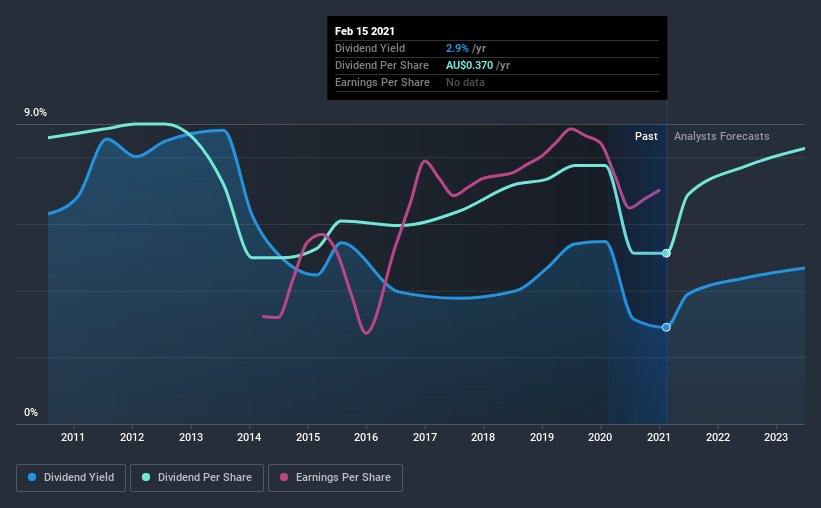Read This Before Considering GUD Holdings Limited (ASX:GUD) For Its Upcoming AU$0.25 Dividend
Readers hoping to buy GUD Holdings Limited (ASX:GUD) for its dividend will need to make their move shortly, as the stock is about to trade ex-dividend. You can purchase shares before the 19th of February in order to receive the dividend, which the company will pay on the 5th of March.
GUD Holdings's next dividend payment will be AU$0.25 per share, and in the last 12 months, the company paid a total of AU$0.37 per share. Last year's total dividend payments show that GUD Holdings has a trailing yield of 2.9% on the current share price of A$12.75. We love seeing companies pay a dividend, but it's also important to be sure that laying the golden eggs isn't going to kill our golden goose! So we need to check whether the dividend payments are covered, and if earnings are growing.
Check out our latest analysis for GUD Holdings
Dividends are typically paid from company earnings. If a company pays more in dividends than it earned in profit, then the dividend could be unsustainable. GUD Holdings paid out 68% of its earnings to investors last year, a normal payout level for most businesses. That said, even highly profitable companies sometimes might not generate enough cash to pay the dividend, which is why we should always check if the dividend is covered by cash flow. Fortunately, it paid out only 40% of its free cash flow in the past year.
It's positive to see that GUD Holdings's dividend is covered by both profits and cash flow, since this is generally a sign that the dividend is sustainable, and a lower payout ratio usually suggests a greater margin of safety before the dividend gets cut.
Click here to see the company's payout ratio, plus analyst estimates of its future dividends.
Have Earnings And Dividends Been Growing?
Stocks in companies that generate sustainable earnings growth often make the best dividend prospects, as it is easier to lift the dividend when earnings are rising. If earnings decline and the company is forced to cut its dividend, investors could watch the value of their investment go up in smoke. This is why it's a relief to see GUD Holdings earnings per share are up 6.3% per annum over the last five years. While earnings have been growing at a credible rate, the company is paying out a majority of its earnings to shareholders. Therefore it's unlikely that the company will be able to reinvest heavily in its business, which could presage slower growth in the future.
We'd also point out that GUD Holdings issued a meaningful number of new shares in the past year. Trying to grow the dividend while issuing large amounts of new shares reminds us of the ancient Greek tale of Sisyphus - perpetually pushing a boulder uphill.
The main way most investors will assess a company's dividend prospects is by checking the historical rate of dividend growth. GUD Holdings has seen its dividend decline 5.0% per annum on average over the past 10 years, which is not great to see. It's unusual to see earnings per share increasing at the same time as dividends per share have been in decline. We'd hope it's because the company is reinvesting heavily in its business, but it could also suggest business is lumpy.
Final Takeaway
From a dividend perspective, should investors buy or avoid GUD Holdings? While earnings per share growth has been modest, GUD Holdings's dividend payouts are around an average level; without a sharp change in earnings we feel that the dividend is likely somewhat sustainable. Pleasingly the company paid out a conservatively low percentage of its free cash flow. In summary, it's hard to get excited about GUD Holdings from a dividend perspective.
So while GUD Holdings looks good from a dividend perspective, it's always worthwhile being up to date with the risks involved in this stock. Case in point: We've spotted 3 warning signs for GUD Holdings you should be aware of.
If you're in the market for dividend stocks, we recommend checking our list of top dividend stocks with a greater than 2% yield and an upcoming dividend.
This article by Simply Wall St is general in nature. It does not constitute a recommendation to buy or sell any stock, and does not take account of your objectives, or your financial situation. We aim to bring you long-term focused analysis driven by fundamental data. Note that our analysis may not factor in the latest price-sensitive company announcements or qualitative material. Simply Wall St has no position in any stocks mentioned.
Have feedback on this article? Concerned about the content? Get in touch with us directly. Alternatively, email editorial-team (at) simplywallst.com.

 Yahoo Finance
Yahoo Finance 
